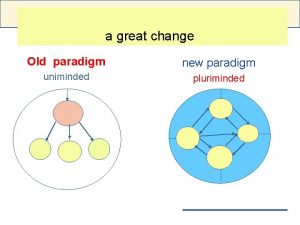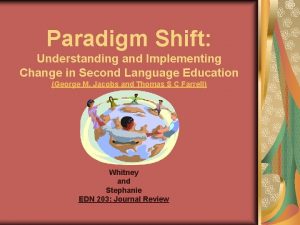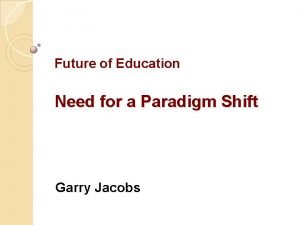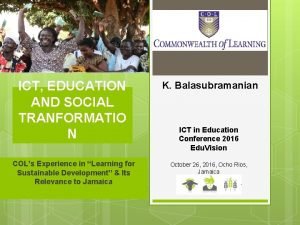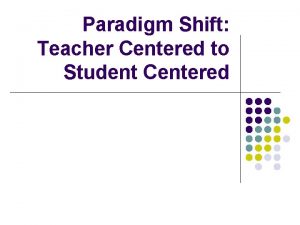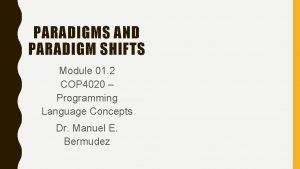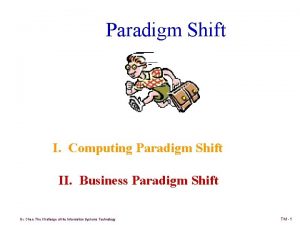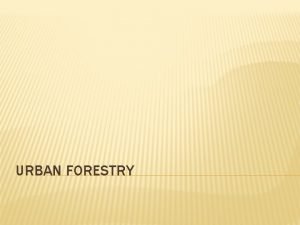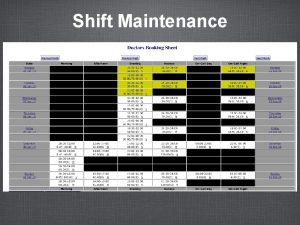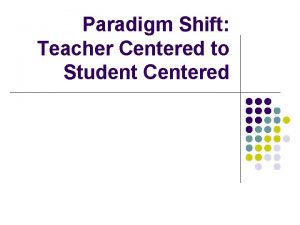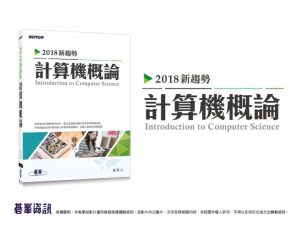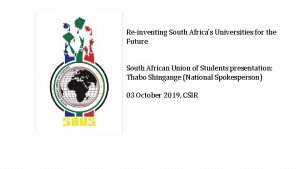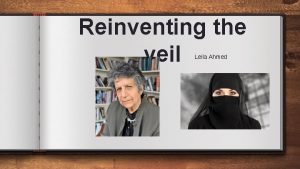Reinventing Forestry Education Critical needs Paradigm shift new
















- Slides: 16

Reinventing Forestry Education Critical needs: Paradigm shift, new and refreshed learning resources, more investment in ‘forestry’ education capacity.

Multi Functional landscapes


Tree cover on farms is increasing due to: § Decline of natural forest cover accessible to villagers § Farm sizes declining – intensification & diversification § Rapid urbanization (6%/yr) rapidly increasing demand for tree products § Demand for timber as a farm-grown crop increasing due to rapid economic growth while forest-sourced timber declines

Trees on agricultural land Figure 1. Tree cover on agricultural land – does not include non-agricultural lands and urban areas. (Source - Hansen et al. 2003)

Current trends § Sharp decline in training of forest technicians in many countries § General decline in enrolments even at BSc level § Paradigm shifts: tended to be unlear, reactive and donor driven § Net effect is a poor conception of “forestry” and its place in national development

Trends contd. § A Shrinking job market for traditional forestry graduates § Poor integration of emerging themes, e. g. biodiversity, Climate change, environment and agroforestry § Inadequate investment in the forestry sector: leading to weak markets for graduates § Low capacity and poor funding forestry research at universities

Indicators of change § Between 1993 and 2002, curricula reforms in various forestry/agriculture training institutions § Limited shift towards multidisciplinarity and NRM § General break-up of traditional forestry programmes in the world

Needed improvements 1. Assess and meet capacity needs! Manage relevance; e. g. § Need to put education in the context of livelihoods and rural development § Linking to environment and climate change 2. Manage quality • Replenish attrition of educators • Use a systems approach to teaching! – Forestry can no longer be isolated from other landscape management

Reflections § Expanded societal demands on forests have created difficulties in defining /concretizing what forestry is! § For SFM, a new breed of well trained managers is needed: how do we balance classical forestry with “multiple use forestry”?

Education model Fibre products (Wood industries, energy) Genetic resources (As biodiversity reserves) Water quality and yield management Non-wood products (Food, medicines, fodder) Science and innovation with trees and forests Climate change (Mitigation and adaptation, carbon trade) Landscape values and environment (Aesthetics, tourism, absorption of toxins) Principles: Livelihood and Envir. sustainability Resource dynamics, policy, sociology, economics and business.

Policy and institutions § Strategic investment at the right levels of education (vocational through professional): balance between basic and applied research § Improving curricula /research innovations § Improving pedagogy , esp. more interactive learning approaches § Links to development and business orientation (enterprise training/problem driven research) § Encouraging private sector participation

Way forward § There is urgent need to envision the direction forestry and develop future models § Form strong linkages between training and research institutions § Form strategic regional educational and research networks § Establish a global monitoring and support mechanism

Key Questions § Can forestry be defined to include trees in non forest landscapes? § How can forestry meet the multi-sectoral needs? What new institutional arrangements are necessary? § What are the new innovations needed in tree and forest resources assessment? § Should forestry education remain as a distinct discipline or breakup into components to fit into other disciplines? l ?

Forestry Education Institutions in SSA Technician, First degree and PG education Technician and first degree education Technician training No forestry training Countries endowed with extensive forest resources do not have strong programmes in forestry education

 Old paradigm vs new paradigm examples
Old paradigm vs new paradigm examples Paradigm shift in education
Paradigm shift in education Paradigm shift in education
Paradigm shift in education Critical semi critical and non critical instruments
Critical semi critical and non critical instruments Critical semi critical and non critical instruments
Critical semi critical and non critical instruments Inventing and reinventing organizations
Inventing and reinventing organizations How to expand your business without reinventing the wheel
How to expand your business without reinventing the wheel Ipsos censydiam
Ipsos censydiam Paradigm shift from women studies to gender studies
Paradigm shift from women studies to gender studies Conclusion of ict in education
Conclusion of ict in education Crime tree
Crime tree Initiative progressive era definition
Initiative progressive era definition Paradigm shift in technology
Paradigm shift in technology Paradigm shift teacher-centered to student-centered
Paradigm shift teacher-centered to student-centered Paradigm shift in technology
Paradigm shift in technology Paradigm shift meaning
Paradigm shift meaning Paradigm examples
Paradigm examples
